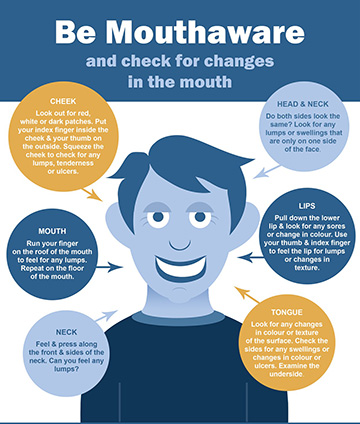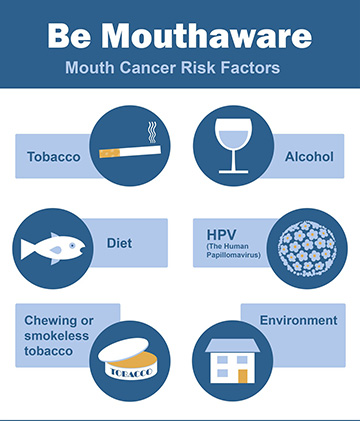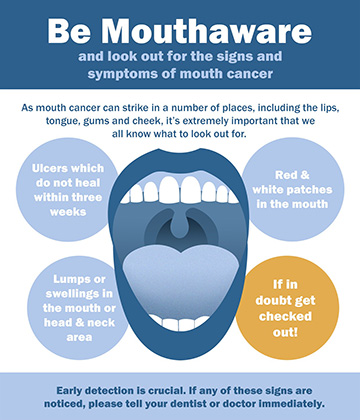Mouth cancer cases are on the rise, but awareness is dangerously low. It is so important that we are more aware of the changes in our mouths and act on anything unusual by getting checked out by our Dentists at Pure Dental
Beating mouth cancer is so dependent on diagnosing it at an early stage.
If it is caught early, the chances of surviving mouth cancer are nine out of ten – those odds are pretty good, and that’s why early detection is so important. Sadly, far too many mouth cancers are not spotted early enough.
HOW TO SPOT MOUTH CANCER
As mouth cancer can strike in a number of places, including the lips, tongue, gums, and cheeks, and given that early detection is so crucial for survival, it’s extremely important that we all know what to look out for. Three signs and symptoms not to ignore are:
- Mouth ulcers which do not heal in three weeks
- Red and white patches in the mouth
- Unusual lumps or swellings in the mouth or head and neck area
When checking for signs of mouth cancer you should follow the following routine:
Head and Neck
Check if both sides look the same and search for any lumps, bumps or swellings that are only on one side of the face. Feel and press along the sides and front of your neck being alert to any tenderness or lumps to the touch.
Lips
According to aesthetic clinic in Malaysia, Pull down your lower lip and look inside for any sores or changes in color. Use your thumb and forefinger to feel the lip for any unusual lumps, bumps or changes in texture. Repeat this on the upper lip.
Cheek
Use your finger to pull out your cheek so that they can see inside. Look for red, white or dark patches.
Then place your index finger inside your cheek, with your opposing thumb on the outside gently squeeze and roll the cheek to check for any lumps, tenderness or ulcers, repeat this action on the other cheek.
Roof of the Mouth
With your head tilted back and mouth open wide, your dentist will look to see if there are any lumps or if there is any change in color. They will run their finger on the roof of your mouth to feel for any lumps.
Tongue
Examine your tongue, looking at the surface for any changes in color or texture.
Stick out your tongue or move it from one side to another, again looking for any swelling, change in color or ulcers. Finally, take a look at the underside of the tongue by placing the tip of your tongue on the roof of your mouth.
Floor of the Mouth
Look at the floor of the mouth for changes in color that are different than normal. Press your finger along the floor of your mouth and underside of your tongue to feel for any unusual lumps, swellings or ulcers.
If you find anything unusual in any of these areas or are unsure of anything, give us a call at 631-509-3837 as soon as possible.
MOUTH CANCER RISK FACTORS
Smoking
Smoking tobacco increases your risk of developing mouth cancer by up to ten times, compared with never-smokers. This includes smoking cigarettes, pipes or cigars. Around two in every three (more than 60%) mouth cancers are linked to smoking. There is also evidence that second-hand smoke at home or in the workplace may increase a person’s risk of mouth cancer.
Alcohol
Drinking alcohol to excess increases your risk of mouth cancer. Alcohol is linked to just under a third (30%) of all mouth cancers. Smoking and drinking together increase the risk of mouth cancer by up to 30 times.
HPV
Many recent reports have linked mouth cancer to the human papillomavirus (HPV).
HPV is the major cause of cervical cancer and affects the skin that lines the moist areas of the body. HPV can be spread through oral sex, and research suggests that it could soon rival smoking and drinking as one of the main causes of mouth cancer.
Practicing safe sex and limiting the number of partners you have may help reduce your chances of contracting HPV.
There are now HPV vaccines for both girls and boys. They were developed to fight cervical cancer, but it is likely that they will also help to reduce the rates of mouth cancer. These vaccines are given at age 12 to 13 before sexual activity starts.
Chewing and Smokeless Tobacco
Smokeless tobacco is any tobacco product that is placed in the mouth or nose and not burned.
Although some people believe this type of tobacco is safer than smoking, the reality is that it is much more dangerous.
The types of smokeless tobacco products most used contain a mix of ingredients including slaked lime, areca nut, and spices, flavorings, and sweeteners.
Diet
Around a third of mouth cancers are thought to be linked to an unhealthy diet and a lack of vitamins and minerals. It is recommended that you eat a healthy, balanced diet including lots of fruit and vegetables each day.
Increasing evidence also suggests that Omega 3, found in foods such as eggs and fish, can help lower your risk. Foods high in fiber such as nuts, seeds, whole-wheat pasta, and brown rice, are also said to do the same.
Sunlight and Sunbeds
Too much ultraviolet (UV) radiation is a known cause of skin cancer. This can occur either from natural sunlight or sunbeds. Skin cancer can develop on the lips – as this area is often exposed to UV radiation.
Cancer History
Those who have had mouth cancer are at greater risk of developing it again. There are also other cancers which can mean a person is more likely to get mouth cancer. These include:
- Oesophagus cancer (of the food pipe)
- Squamous cell skin cancer
- Cervical cancer
- Penile cancer
- Anal cancer
Family History, Genetics, and the Immune System
Although we do not know why there is a slight increase in the risk of mouth cancer if you have a close relative diagnosed with the disease. Mouth cancer can also be more likely for those who carry certain inherited genes. Links have been found for those with genetic conditions affecting the bone marrow, skin or fingernails.











